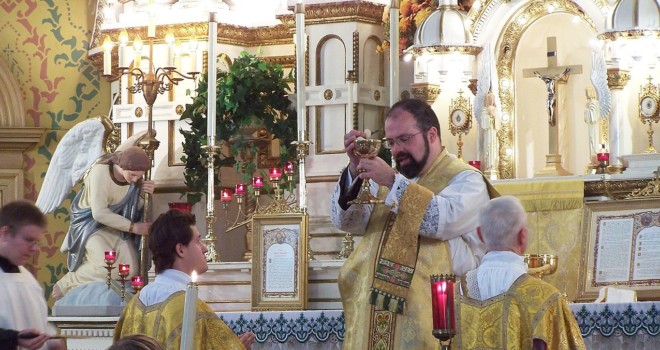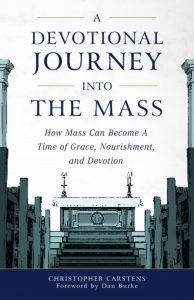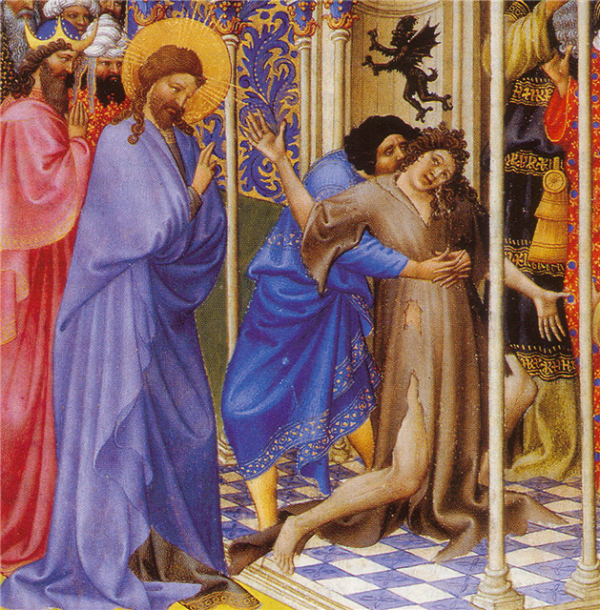How to Receive Communion to the Fullest

Daily Reading & Meditation: Saturday (February 10)
February 10, 2018
Nancy Pelosi Finds an Impressive New Low in Her Long-Winded House Speech
February 10, 2018
To the victor I will give the right to eat from the
tree of life that is in the garden of God. ~Revelation 2:7
 Any road trip requires energy. Fast-food restaurants know this, and their siren songs — the waft of cooking oil carrying the unmistakable scent of french fries — have tempted many a traveler to pass through their drive-throughs. Gas stations also gear their business to the weary wanderer, their aisles filled with every imaginable road snack. But such food, while providing a short-term carbohydrate gain is often a long-term digestive loss. Rarely is the pilgrim unequivocally satisfied after succumbing to the variety in road-trip fare. Indeed, Twinkies, beef jerky, potato chips, and caffeine- and sugar-laced drinks are nowhere to be found by the USDA on yesterday’s food pyramid or today’s nutrition food plate.
Any road trip requires energy. Fast-food restaurants know this, and their siren songs — the waft of cooking oil carrying the unmistakable scent of french fries — have tempted many a traveler to pass through their drive-throughs. Gas stations also gear their business to the weary wanderer, their aisles filled with every imaginable road snack. But such food, while providing a short-term carbohydrate gain is often a long-term digestive loss. Rarely is the pilgrim unequivocally satisfied after succumbing to the variety in road-trip fare. Indeed, Twinkies, beef jerky, potato chips, and caffeine- and sugar-laced drinks are nowhere to be found by the USDA on yesterday’s food pyramid or today’s nutrition food plate.
The famed and famished Israelite pilgrims of the Old Covenant could probably relate to the modern-day road trip. True, they passed no roadside convenience store on their desert trek — even if their stomachs growled for the apparently unhealthy cucumbers, melons, leeks, onions, and garlic of their former lives (Num. 11:5). (How the food pyramid has changed over the centuries!) They knew that crossing over the desert required nourishing food and drink. God knew this too and — even if He and His people quibbled from time to time about just what was on the menu — being the good Father He is, He provided manna from heaven and water from a rock.
As the pilgrim Church on earth traveling to our final home in heaven, Catholics also know something about the necessity of food for the journey. Recall that, as baptized priests, all the Catholic faithful are passing over a bridge that spans fallen earth to glorious heaven. Jesus has made it less laborious — He does most of the heavy lifting in the project — but for the rest of us, suffering from the effects of original sin, it is nonetheless dangerous (for that sinful chasm is deep) and still requires effort. Here too God has provided food and drink to sustain us: the Eucharist. But unlike roadside junk food that kills the digestion, or even the Manna from heaven that sustained only for the short term (“Your ancestors ate the manna in the desert, but they died” [John 6:49]), the Mass’s Eucharistic bread and wine is out of this world.
Many of the Mass’s roads converge when it comes time for receiving Holy Communion. The Cross is likened to the tree of life. In the Garden of Eden stood a tree of life, one from which our first parents were free to eat; in heaven’s “garden of God” stands another tree of life from which the victorious have the right to eat (Rev. 2:7); and in between rises the Cross of Jesus, whose fruit is the Eucharist — and from which the world’s pilgrims must eat along the journey. Thus, the wood of the Tree of the Cross that built the heart’s bridge to God in the Eucharistic Prayer presents us now with another way to participate in the divine life of Jesus.
This article is from a chapter in “A Devotional Journey into the Mass.” Click image to preview or order.
“Active participation” in the Mass — called by the Second Vatican Council “the aim to be considered before all else” — is intimately associated with the worthy reception of the Eucharist. Sixty years before the Council, Pope St. Pius X (d. 1914) first used the term “active participation” on behalf of the magisterium shortly after assuming the throne of St. Peter. On the doorstep of the First World War, Pius X sought “to restore all things in Christ” (his papal motto) by infusing the unstable world with a healthy dose of the true Christian spirit. The two emphases may seem unrelated, but where is this Christian spirit to be found? In the active and authentic participation by the faithful in the saving work of Jesus made present to us today in the liturgy.
But the Eucharist isn’t a magic pill, some kind of supernatural vitamin. On the contrary, the Mass’s consecrated bread and wine are the Body, Blood, Soul, and Divinity of Jesus offered to the Father in the Holy Spirit — and more. Remember all those prayers, works, joys, and sufferings; the fears, loves, sins, hopes, and thanksgivings — that is, your entire human life — that you added to the Church’s gifts of bread and wine when the altar was prepared? These, along with the same sacrifices of each cell of the Mystical Body of Christ, have likewise been given to God and are returned to us transformed. It was the Great Animator, the Holy Spirit, who transformed these gifts, and even He Himself is a part of our lively reception. “He who eats it with faith,” said St. Ephrem, “eats Fire and Spirit. . . . Take and eat this, all of you, and eat with it the Holy Spirit.” Charged with Jesus, on fire with the Holy Spirit, divinized by the Father, and prepared in part by the heartfelt intentions of the world, food like this can only be called “heavenly” — or as we said earlier, “out of this world.” The Mass’s fare is, in fact, the main course of the eternal wedding banquet of Jesus and His Bride, the Church.
But as heavenly as the Eucharist is, it can be hellish to those not ready to receive it — much as the Word of God was sweet as honey in the mouth of St. John before turning sour in his stomach (Rev. 10:10). Food and drink as powerful and substantial as the Blessed Sacrament can be received fruitfully only if we are properly disposed. Not just anyone can eat fire (as St. Ephrem says) without getting burned!
Proper disposition, then, is paramount. The Eucharistic bread and wine is the same for one who is prepared and one who is not — or, similarly, for me on one day when disposed and the next day when not. But the effects could not differ more.
If Communion on a stomach empty of the proper disposition harms us, how can we be sure we have the proper disposition? At a minimum, we are to be free from mortal sin. “To choose deliberately — that is, both knowing it and willing it — something gravely contrary to the divine law and to the ultimate end of man is to commit a mortal sin” (CCC 1874). Mortally sinful acts kill all life in the soul, withering it up like the dead chaff of a field. When it encounters the divine fire of God’s love in the Eucharist, the soul cannot withstand the heat. A proper disposition for Communion includes a soul capable of Eucharistic transformation.
But being in a state of grace is only the minimum required for a fruitful encounter with Jesus. The reason Holy Communion can either save us or damn us is, in part, because of what — or whom — it contains: Jesus, on fire with the Holy Spirit, given to us from the hands of the Father. But the purpose of Jesus’ presence in the Sacrament isn’t simply so He can “remain with us always” in the tabernacle. Rather, the Eucharistic Christ desires an even greater intimacy with us, one brought about through our ingesting Him and our willingness to be changed into Him. And the ingredient (or perhaps the seasoning) necessary for healthy Eucharistic eating is a large dose of humility — the larger, the better.
So again, let us return to Mass to find out how and when best to prepare for receiving this divine feast. The Mass’s preparatory rites immediately prior to receiving Communion dispose us to receive the Body and Blood of the Lord in the spirit of docility, humility, and desire to be transformed into Him. The Lord’s Prayer, the exchange of peace, the breaking of the Eucharistic bread, and the Lamb of God each expresses in its own way how Jesus wishes to bring us from sin, evil, and selfishness to mercy, grace, and communion with Him and the Church. The invitation to Communion puts a great act of humility heard once by a Roman centurion on our lips — making our mouths water for Christ. This soldier’s story ought to be a model for our Eucharistic preparation.
The story begins in Capernaum, a village on the north shore of the Sea of Galilee and the site of many of Jesus’ miracles. On one occasion, Jesus enters the town and is met with the request of a Roman centurion with a suffering servant near death. The centurion asks Jesus to come and heal his servant, yet he does so in all humility. “Lord, I am not worthy to have you enter under my roof; only say the word and my servant will be healed. For I too am a person subject to authority, with soldiers subject to me. And I say to one, ‘Go,’ and he goes; and to another, ‘Come here,’ and he comes; and to my slave, ‘Do this,’ and he does it” (Matt. 8:8–9). A Roman centurion, as his title suggests, commanded up to one hundred Roman soldiers. He was a man of power and authority. Certainly in the eyes of the world he was more important and prestigious than a lowly Jewish carpenter — and more entitled to respect than the Jews at the time, who were subject to Roman, and therefore this centurion’s, authority.
The centurion’s humility is all the more striking because of his high office: it was not as if he were a leprous outcast or a sinful Samaritan. In response to such humility in the face of the Lord, Jesus, “amazed,” responds: “Amen, I say to you, in no one in Israel have I found such faith” (Matt. 8:10). In humility, this authoritative centurion was disposed to receive Jesus under his roof. With his example before our minds and his words in our mouths — “Lord, I am not worthy that you should enter under my roof, but only say the word and my soul shall be healed” — his humility can become ours. And his would-be guest can become ours.
Our posture for receiving Communion can also express and foster our proper disposition to receive Christ in humility. Today, both standing and kneeling are options for the recipient, even though kneeling has been the Mass’s traditional posture. Standing signifies respect and readiness to act, but also independence and self-assurance. Kneeling symbolizes supplication and surrender: one is nearly incapable of acting according to his own power when kneeling, which is an appropriate attitude for divinization.
Like posture, the manner of reception also helps or hinders transformation. Receiving the Lord in the hand or directly on the tongue are the usual options in today’s Mass. If receiving in the hand, do as St. Cyril recommends: “In approaching, come not with your wrists extended, or your fingers spread; but make your left hand a throne for the right, as for that which is to receive a King.”26Over the centuries, Communion on the tongue has established itself as the normative manner for receiving Communion, since, like kneeling, it signifies the necessary humble disposition of receiving, not actively taking. Whichever option you choose, the spiritual attitude of docile transformation must accompany it — without this, the manner risks becoming meaningless.
But even after receiving, Communion is not over any more than the last bite on your plate signals the end of a family meal. Conversation in either case ought to ensue. In Mass, that conversation should take the form of prayer — a prayer for surrender. As St. Augustine and the Capernaum centurion teach us, an encounter with Jesus should transform our fallen selves into Christ’s own heavenly image. Another powerful soldier, St. Ignatius of Loyola, became an authoritative warrior for Christ. His strength was found in humility and surrender, and his prayer, the Suscipe (“Receive!”), is as perfect a prayer after Communion as the centurion’s was before it:
Receive, Lord, my entire freedom. Accept the whole of my memory, my intellect, and my will. Whatever I have or possess, it was You who gave it to me; I restore it to You in full, and I surrender it completely to the guidance of Your will. Give me only love of You together with Your grace, and I am rich enough and ask for nothing more. Amen.
Learning and praying this prayer for surrender after returning to our pew after Communion will ignite in us the humble power of Jesus.
The worthy reception of Holy Communion — when we are in a state of grace and truly desire to be transformed into Jesus — is the most effective way (short of martyrdom) God gives us to attain Him. Through this “fruit of the Cross” we become what we eat.
St. Athanasius famously said, “God became man so that man might become God.” If this is true — and it is! — we become divinized, true sons and daughters of God by the Eucharist. St. Paul encourages us: “I urge you therefore, brothers, by the mercies of God, to offer your bodies as a living sacrifice, holy and pleasing to God, your spiritual worship. Do not conform yourselves to this age but be transformed ” (Rom. 12:1–2, emphasis added). Eucharistic transformation, first of the bread into the Body of Christ, and then of us into the Body of Christ, is the high point on our journey into the Mass.
The items on today’s USDA “food plate” give energy and life to any task or trek. The Eucharistic food on the Mass’s paten bestows the fire of divine life for our journey to God. But as so many Gospel stories recount, encountering God impels us to tell others about Him.
___________________________________
Editor’s note: This article is from a chapter in A Devotional Journey into the Mass, which is available from Sophia Institute Press.
image: By English Wikipedia (Transferred from en.wikipedia to Commons.) [Public domain], via Wikimedia Commons





